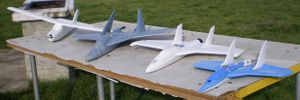|
|
The Paparazzi Project
|
| Paparazzi is a free and open-source hardware and software project intended to create an exceptionally powerful and versatile autopilot system by allowing and encouraging input from the community. The project includes not only the airborne hardware and software, from voltage regulators and GPS receivers to Kalman filtering code, but also a powerful and ever-expanding array of ground hardware and software including modems, antennas, and a highly evolved user-friendly ground control software interface.
|
| All hardware and software is open-source and freely available to anyone under the GNU licencing agreement. Efforts are currently underway to organize production and retail sales of the autopilot and popular accessories, making the system much easier and more affordable for all.
|
| The key feature of the paparazzi autopilot is its unique combination of infrared thermopiles and inertial measurement for attitude sensing, providing a robust and accurate attitude estimate that requires no ground calibration and can recover from any launch attitude.
|
The Paparazzi project at ENAC
|
| The Paparazzi mini UAV project is now being used and developed at ENAC University.
|
|
|
News
|
March 1st, 2007
|
 Part of the ENAC multiplex foamy fleet |
February 5th, 2007
|
|
Jeremie Vacher, a student at ENAC, has developed a tracker for antennas. It is functionnal but still needs a little bit of polishing. Anybody interrested ?
|
December 7th, 2006
|
|
Antoine continues to make great progress toward the holy grail of 17 state inertial navigation and releases a video showing the performance of the 7-state Kalman filtered IMU providing the attitude-heading reference system (AHRS) on his quadrotor. Note how much coffee was consumed in preparation for this video. More info on the IMU is available on the sensors page. Also, be sure to admire the schematics and source code!
|
November 28th, 2006
|
 Michel Gorraz launches the Dragon Slayer for the ENAC team Two Paparazzi teams, ENAC/Miraterre and Martin Mueller/Christian Lindeberg won 2nd and 3rd place at the MAV06 competition. Unfortunately, both teams had insufficient video resolution to identify the 1.5m ground target required for high-scoring and the winning prize went to Bringham Young University who was able to identify 2 of the 3 targets with a Panasonic KX-141 camera and an unusually narrow 30 degree FOV lens. The Bringham Young team used the Procerus Kestrel autopilot (originally developed at the university) and obviously practiced video target recognition much more than the rest of us.
Flight performance and navigation for both Dragon Slayers and the Black One was exceptional as usual. All planes performed flawless autonomous takeoffs and landings and the Slayer performed an autonomous paintball drop with wind-corrected precision that put the ball within 3 meters of the designated target from an altitude of 40 meters in a 5 m/s wind. As luck would have it, the stress of managing two aircraft from a single ground station during an intense competition, aggravated by a misbehaving GPS in one of the planes that required a power and flight-plan reset just prior to launch resulted in us neglecting to re-input the target coordinates and the ball was dropped accurately on the default target location, not the actual target location provided by the judges just prior to flight.
|
| See the complete MAV06 Photo Gallery
|
| See you next year in Toulouse for MAV07.
|
| News Archives
|
|